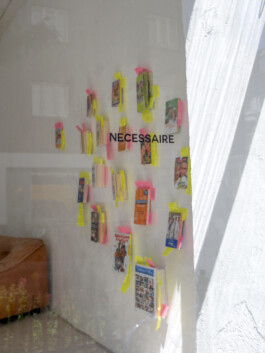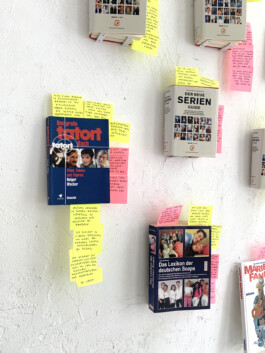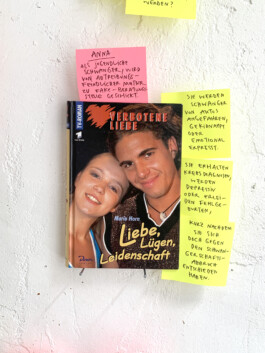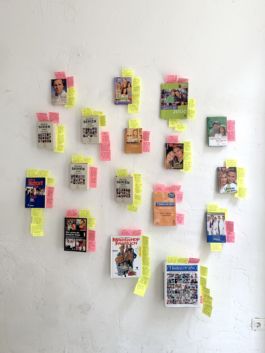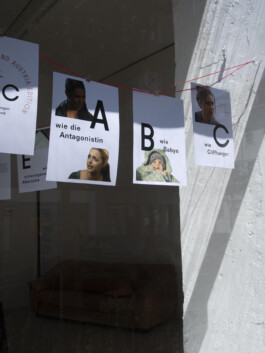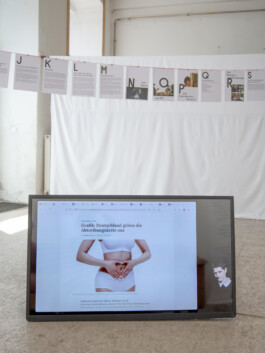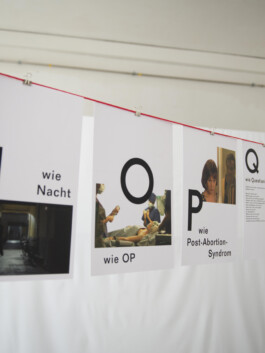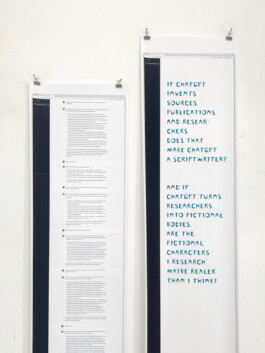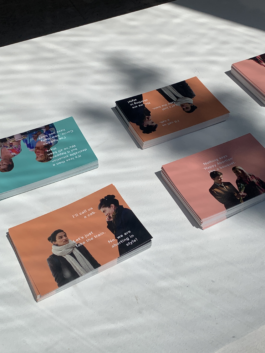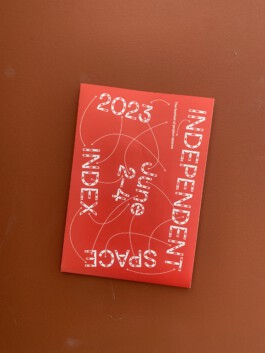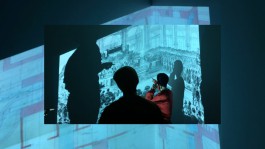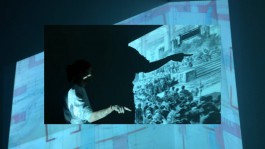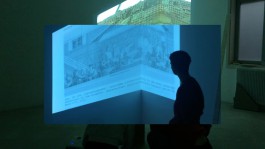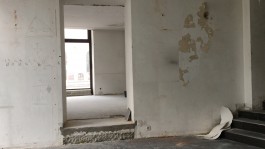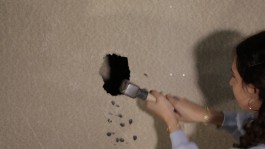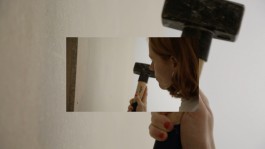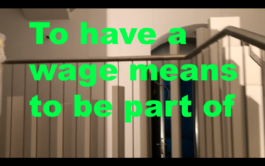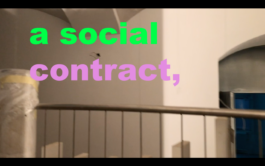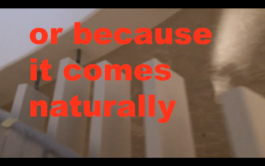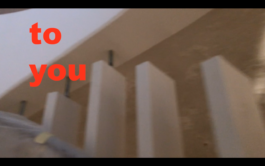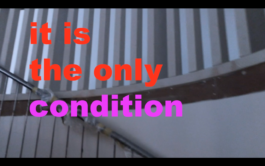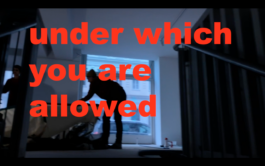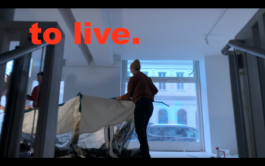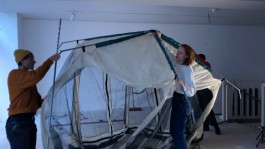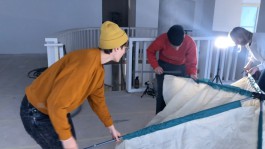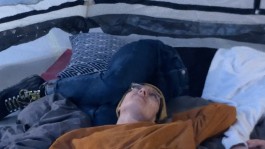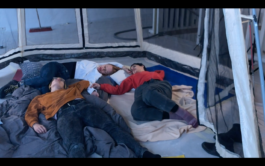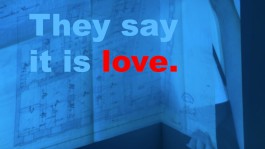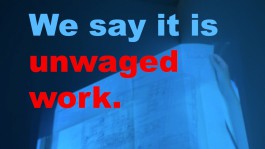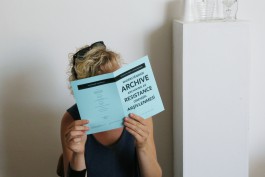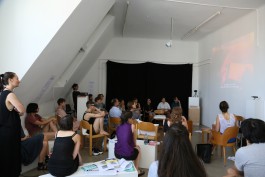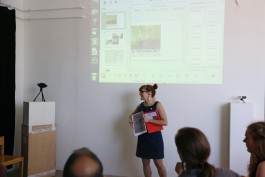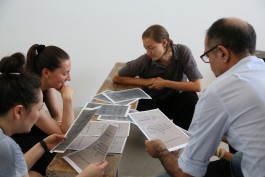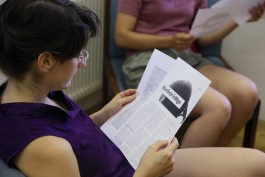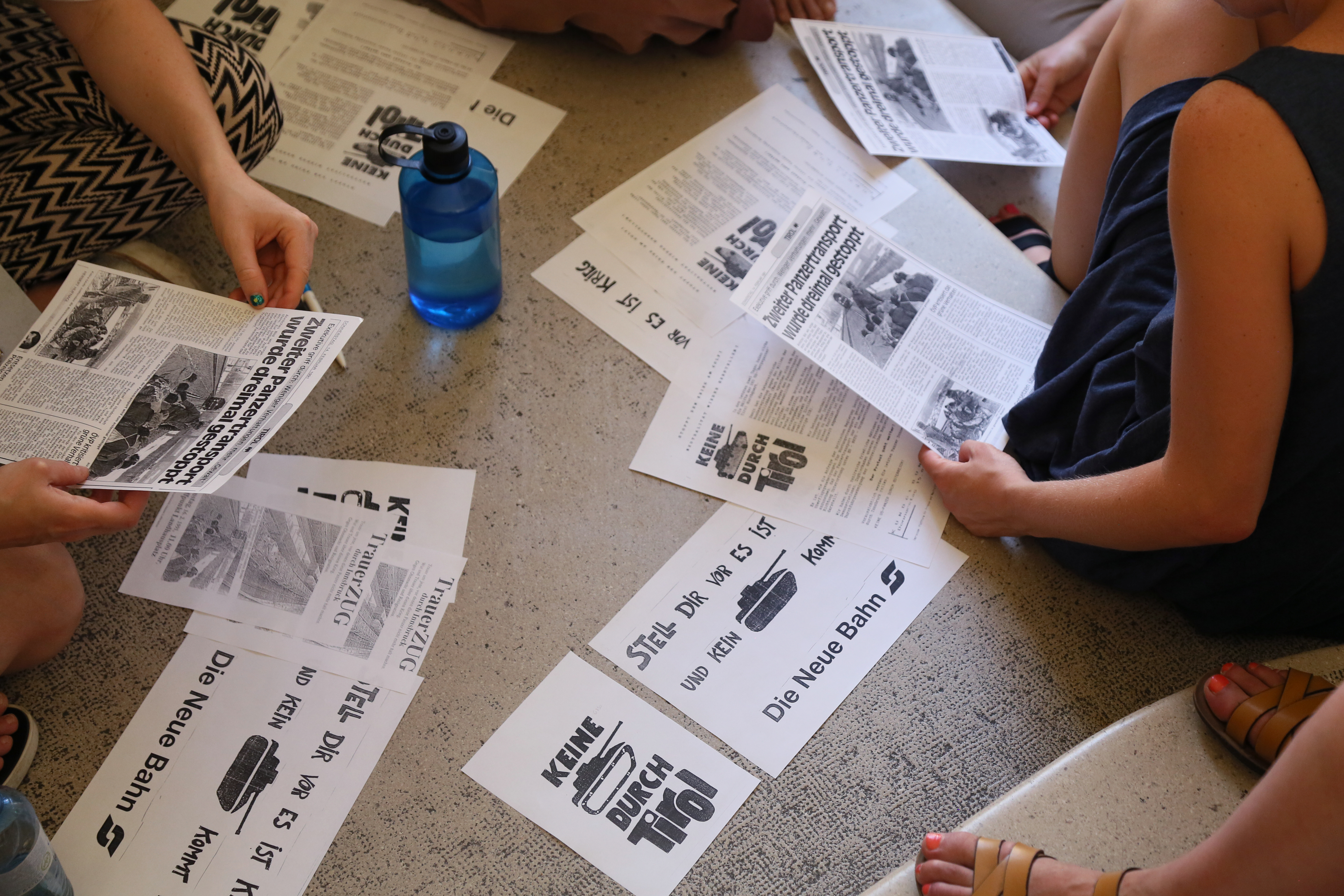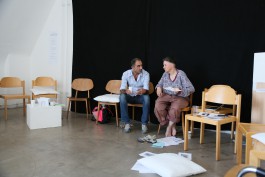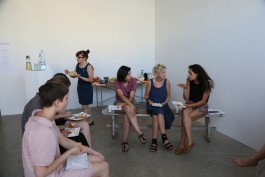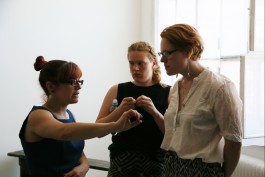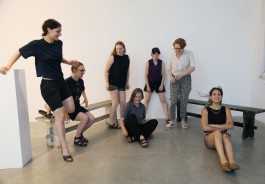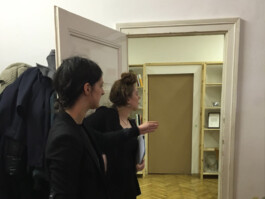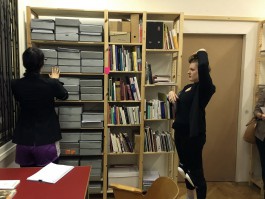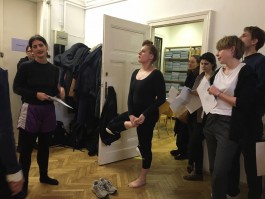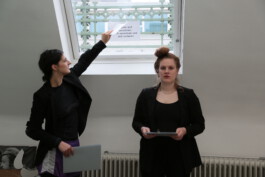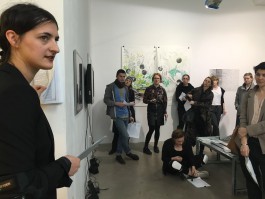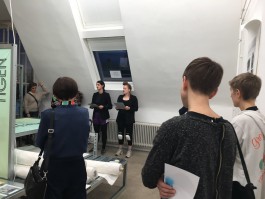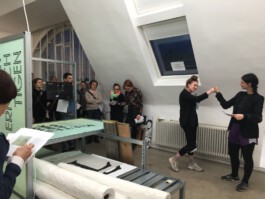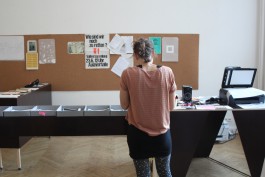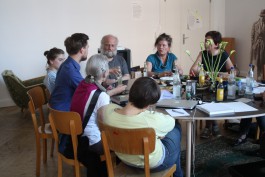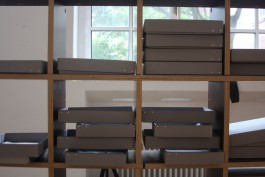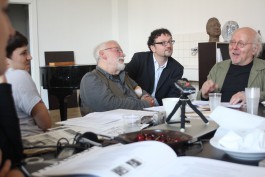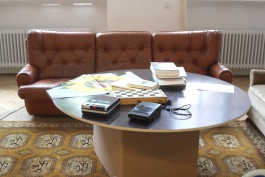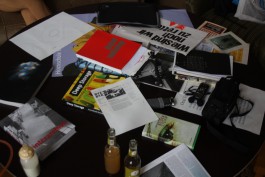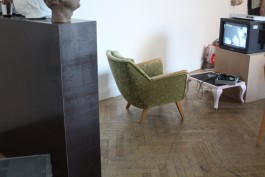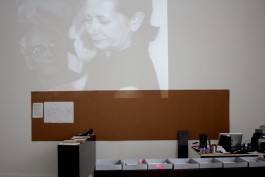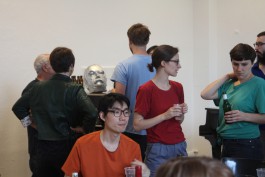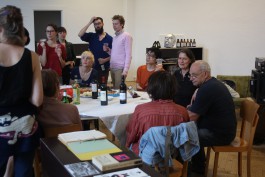PLOT TWIST ABORTION
For the last years, I have been researching the depiction of abortions in film, tv series and media. I am especially interested in the question, how fictional narratives and societal narratives about abortion correspond. My research will result in a documentary feature about the most common narratives, myths and stereotypes as well as a PhD dissertation about this topic. My PhD focus lies on German and Austrian film and television depictions from 1990–2020. Some of my findings I already share on the Instagram account abortion tv.
In June 2023, I exhibited a work in progress at Necessaire Space in Vienna, as part of the Independent Space Index Festival 2023. In this exhibition called “fictional bodies that matter”, I asked whether fictional characters have bodily autonomy and looked at the connection between fictional images and embodied realities. I also juxtaposed the stereotypes created by scriptwriters and the repeated patterns by AI chat bots. Read an exhibition review here.
Recently, I made the short film „getty abortions“ about the depiction of abortion in German-speaking newspapers and magazines. Its world premiere will take place in fall 2023.
I was invited to present and talk about my research at Volksbühne am Rosa-Luxemburg-Platz, Heinrich-Böll-Stiftung Dresden, Galerie im Saalbau Neukölln, University of Applied Arts Vienna, Deutschlandfunk Nova, realitäter*innen, ZEIT (ze.tt), Man lernt nie aus, This is Jane Wayne, Arbeitskreis Frauengesundheit, pro familia Rheinland-Pfalz, Bündnis für sexuelle Selbstbestimmung Münster.
I published texts about my research and various aspects like abortion in comedies, the connection between motherhood and abortion, or the notion of positive images in Zeitschrift Kunst Medien Bildung, derStandard, taz, MALMOE, Edition F, fluter, and the publications of Galerie im Saalbau Neukölln and Xenix Kino.
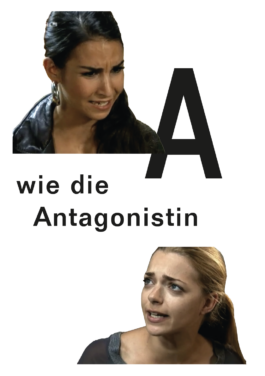
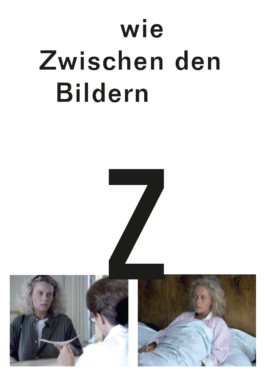
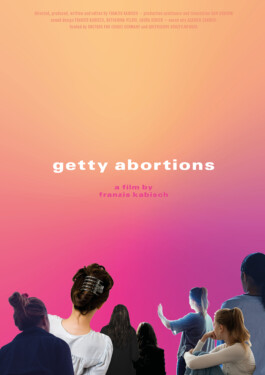
PA-PA-PA.
WE SAY IT'S UNWAGED WORK
research project and short film by ff. Feministisches Fundbüro
2019, 20 min, HD, colour, stereo, de/en
ff. Feministisches Fundbüro is a collective whose artistic research focuses on queer-feminist archival politics, history, work, and emotions. It takes care of things lost by their authors, owners, and minders and gives them a place in feminist historiography. Its members for this project were Malu Blume, Andrea Haas, İpek Hamzaoğlu, Franzis Kabisch and Juliane Saupe.
When invited to participate in the exhibition “Dark Energy. Feminist organizing, working collectively” we, a group of artists who had worked on archive politics before, decided to investigate the site of the exhibition, the Palais Eschenbach. Then still a construction site, it was meant to turn into a new prestigious art space from the Academy of Fine Arts Vienna.
Our film “Pa-Pa-Pa. We say it's unwaged work” shows our journey through the building, but also through the history of female and feminized work, in the art context and others spheres. In combination to our dealing with the construction site, we researched the forgotten (or neglected) pavillon of women‘s work in the World Fair in Vienna 1873 of which exists little to almost no documentation. Through images, sounds and our own voices, we ask ourselves about the connection between the value of female labour then and unpaid work in the art context today.
The film was shown in the exhibition Dark Energy. Feminist Organizing, Working Collectively and in the exhibition Wie wir arbeiten wollen – kollektives Handeln und künstlerische Komplizinnenschaft in das weisse haus vienna.
WIDERSTÄNDIGE ARCHIVE.
RESISTING ARCHIVES.
DIRENIŞIN ARSIVLENMEŞI.
archive research project and public one-day event, 2015
together with Julia Wieger, İpek Hamzaoğlu, Malu Blume, Juliane Saupe, Andrea Haas, Ruth Lang, Katharina Swoboda
For several weeks, our working group was looking into queer feminist archives – first in a seminar at the Academy of Fine Arts Vienna, and later on with a specific focus on the archive of the VBKÖ (Vereinigung bildender Künstlerinnen Österreichs, English: Austrian Association of Women Artists). On the occasion of the VBKÖ’s 100th birthday, we were looking for gaps, erasures and absences, for example during World War II and the post-war period. To all the questions that remained unanswered in the archive, we tried to respond with artistic methods and practices.
For the project and presentation day, we invited other self-organized archives (bildwechsel in Hamburg, Archiv der Migration Wien, Stichwort-Archiv Wien) to share their practices and experiences about non-linear history and anti-hegemonic archiving. Furthermore, we presented parts and results of our research, including talks, readings, lecture performances, installations, discussions, etc.
Together with Malu Blume, I developed and presented the lecture performance “Wer tanzt im Archiv?” which deals with embodied knowledge and bodies in archives. It was shown in the context of the Widerständige Archive project, als well as in the exhibition Die Kunst der Frau – Freundinnen und Komplizinnen in the VBKÖ.
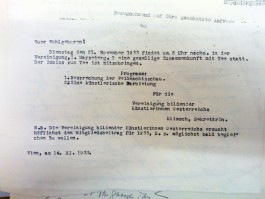

Excerpts from our invitation:
WHAT CONSTITUTES A RESISTING ARCHIVE?
Is it the documented realities – events, experiences, feelings?
Is it the relations to hegemonic institutions and dominant narratives?
HOW CAN ARCHIVING BECOME RESISTANCE?
Is it about claims and demands?
About making marginalized histories visible?
Is it about practices of archiving?
Is it about the contextualization of an archive, or the production of a space?
About access or the creation of a public?
CAN RESISTANCE BE ARCHIVED?
What are the ways to capture it?
In which language?
How can one read it?
And where are the limits of archiving?
What cannot be kept in an archive?
Can an atmosphere or attitude be saved?
ORAL FISTORY
archive project about forgotten and neglected stories in the history of HFBK Hamburg, 2013
multi-day-event, room 11,
together with Clara Wellner Bou, Michael Bauer, Laura Nitsch, Dominik Mayer, Nikola Hartl, Marcela Braak
invitation text:
It is not an archive, we use archives and archival working methods. In room 11 you can find different presenting and archiving strategies and systems. We are interested in positions acting alternatively and critically in the context of the institution HFBK – meaning different teaching methods, value production, the notion of art and history writing. The various displays during the year-end-exhibition 2013 are discussable and usable. Room 11 acts as a place to dwell, discuss, observe, read, think, reflect and question.

ARTISTIC RESEARCH
PLOT TWIST ABORTION


For the last years, I have been researching the depiction of abortions in film, tv series and media. I am especially interested in the question, how fictional narratives and societal narratives about abortion correspond. My research will result in a documentary feature about the most common narratives, myths and stereotypes as well as a PhD dissertation about this topic. My PhD focus lies on German and Austrian film and television depictions from 1990–2020. Some of my findings I already share on the Instagram account abortion tv.
In June 2023, I exhibited a work in progress at Necessaire Space in Vienna, as part of the Independent Space Index Festival 2023. In this exhibition called “fictional bodies that matter”, I asked whether fictional characters have bodily autonomy and looked at the connection between fictional images and embodied realities. I also juxtaposed the stereotypes created by scriptwriters and the repeated patterns by AI chat bots. Read an exhibition review here.
Recently, I made the short film „getty abortions“ about the depiction of abortion in German-speaking newspapers and magazines. Its world premiere will take place in fall 2023.

I was invited to present and talk about my research at Volksbühne am Rosa-Luxemburg-Platz, Heinrich-Böll-Stiftung Dresden, Galerie im Saalbau Neukölln, University of Applied Arts Vienna, Deutschlandfunk Nova, realitäter*innen, ZEIT (ze.tt), Man lernt nie aus, This is Jane Wayne, Arbeitskreis Frauengesundheit, pro familia Rheinland-Pfalz, Bündnis für sexuelle Selbstbestimmung Münster.
I published texts about my research and various aspects like abortion in comedies, the connection between motherhood and abortion, or the notion of positive images in Zeitschrift Kunst Medien Bildung, derStandard, taz, MALMOE, Edition F, fluter, and the publications of Galerie im Saalbau Neukölln and Xenix Kino.
PA-PA-PA.
WE SAY IT'S UNWAGED WORK
research project and short film by ff. Feministisches Fundbüro
2019, 20 min, HD, colour, stereo, de/en
ff. Feministisches Fundbüro is a collective whose artistic research focuses on queer-feminist archival politics, history, work, and emotions. It takes care of things lost by their authors, owners, and minders and gives them a place in feminist historiography. Its members for this project were Malu Blume, Andrea Haas, İpek Hamzaoğlu, Franzis Kabisch and Juliane Saupe.
When invited to participate in the exhibition “Dark Energy. Feminist organizing, working collectively” we, a group of artists who had worked on archive politics before, decided to investigate the site of the exhibition, the Palais Eschenbach. Then still a construction site, it was meant to turn into a new prestigious art space from the Academy of Fine Arts Vienna.
Our film “Pa-Pa-Pa. We say it's unwaged work” shows our journey through the building, but also through the history of female and feminized work, in the art context and others spheres. In combination to our dealing with the construction site, we researched the forgotten (or neglected) pavillon of women‘s work in the World Fair in Vienna 1873 of which exists little to almost no documentation. Through images, sounds and our own voices, we ask ourselves about the connection between the value of female labour then and unpaid work in the art context today.
The film was shown in the exhibition Dark Energy. Feminist Organizing, Working Collectively and in the exhibition Wie wir arbeiten wollen – kollektives Handeln und künstlerische Komplizinnenschaft in das weisse haus vienna.
WIDERSTÄNDIGE ARCHIVE.
RESISTING ARCHIVES.
DIRENIŞIN ARSIVLENMEŞI.
archive research project and public one-day event, 2015
together with Julia Wieger, İpek Hamzaoğlu, Malu Blume, Juliane Saupe, Andrea Haas, Ruth Lang, Katharina Swoboda
For several weeks, our working group was looking into queer feminist archives – first in a seminar at the Academy of Fine Arts Vienna, and later on with a specific focus on the archive of the VBKÖ (Vereinigung bildender Künstlerinnen Österreichs, English: Austrian Association of Women Artists). On the occasion of the VBKÖ’s 100th birthday, we were looking for gaps, erasures and absences, for example during World War II and the post-war period. To all the questions that remained unanswered in the archive, we tried to respond with artistic methods and practices.
For the project and presentation day, we invited other self-organized archives (bildwechsel in Hamburg, Archiv der Migration Wien, Stichwort-Archiv Wien) to share their practices and experiences about non-linear history and anti-hegemonic archiving. Furthermore, we presented parts and results of our research, including talks, readings, lecture performances, installations, discussions, etc.
Together with Malu Blume, I developed and presented the lecture performance “Wer tanzt im Archiv?” which deals with embodied knowledge and bodies in archives. It was shown in the context of the Widerständige Archive project, als well as in the exhibition Die Kunst der Frau – Freundinnen und Komplizinnen in the VBKÖ.


Excerpts from our invitation:
WHAT CONSTITUTES A RESISTING ARCHIVE?
Is it the documented realities – events, experiences, feelings?
Is it the relations to hegemonic institutions and dominant narratives?
HOW CAN ARCHIVING BECOME RESISTANCE?
Is it about claims and demands?
About making marginalized histories visible?
Is it about practices of archiving?
Is it about the contextualization of an archive, or the production of a space?
About access or the creation of a public?
CAN RESISTANCE BE ARCHIVED?
What are the ways to capture it?
In which language?
How can one read it?
And where are the limits of archiving?
What cannot be kept in an archive?
Can an atmosphere or attitude be saved?
ORAL FISTORY
archive project about forgotten and neglected stories in the history of HFBK Hamburg, 2013
multi-day-event, room 11,
together with Clara Wellner Bou, Michael Bauer, Laura Nitsch, Dominik Mayer, Nikola Hartl, Marcela Braak
invitation text:
It is not an archive, we use archives and archival working methods. In room 11 you can find different presenting and archiving strategies and systems. We are interested in positions acting alternatively and critically in the context of the institution HFBK – meaning different teaching methods, value production, the notion of art and history writing. The various displays during the year-end-exhibition 2013 are discussable and usable. Room 11 acts as a place to dwell, discuss, observe, read, think, reflect and question.

